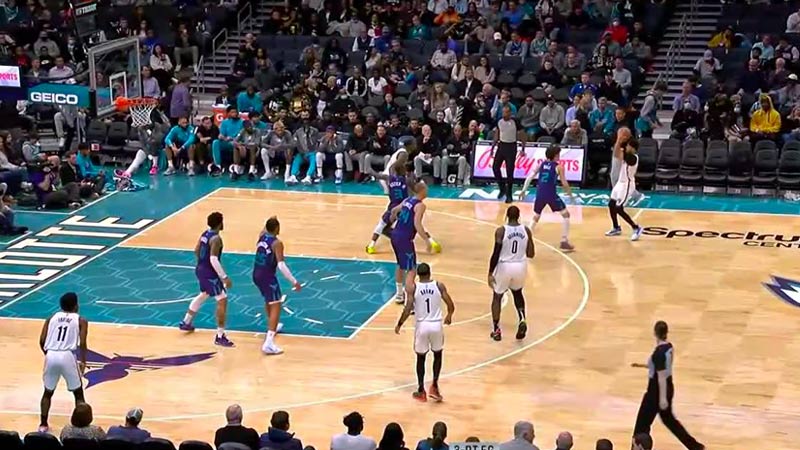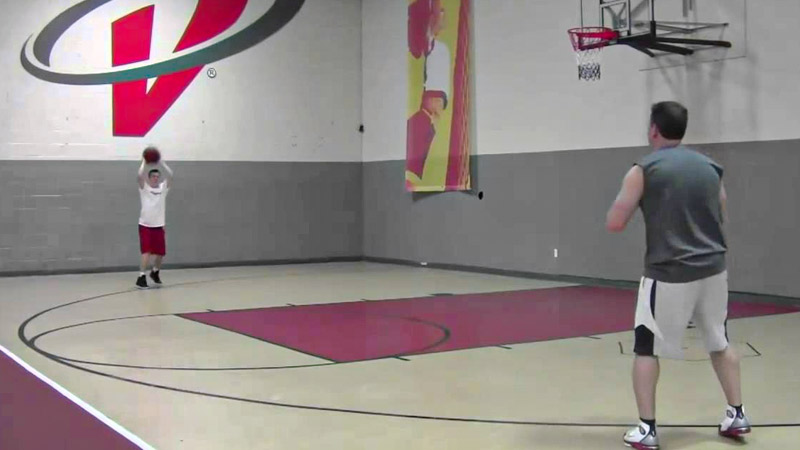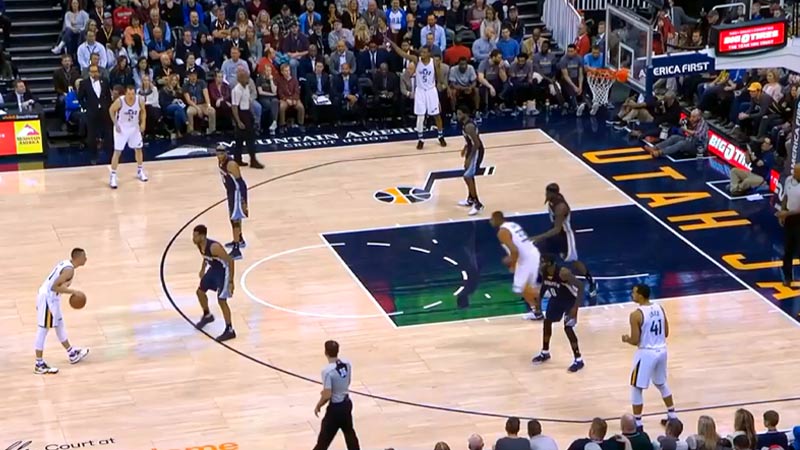Basketball is a fast-paced game that requires quick decision-making and precise passing. One advanced passing technique that adds versatility and unpredictability to a team’s offense is the “skip pass.”
A skip pass is a long, cross-court pass that bypasses one or more defenders to reach an open teammate on the opposite side of the court.
It is a powerful tool that allows teams to quickly shift the defense, create scoring opportunities, and exploit open shooters.
In this blog post, we will delve into the intricacies of the skip pass in basketball, exploring its mechanics, variations, execution, and significance within the game.
What Is a Skip Pass in Basketball?
A skip pass in basketball is a long, cross-court pass that allows players to quickly shift the ball from one side of the court to the other, bypassing defenders and creating scoring opportunities.
It is a powerful technique that enhances ball movement, disrupts defensive rotations, and exploits open shooters. By utilizing the skip pass, teams can force the defense to adjust and create open passing lanes or driving opportunities.
This advanced passing technique requires good court vision, timing, and accurate passing to deliver the ball to the intended recipient on the opposite side of the court.
Incorporating skip passes into a team’s offensive strategy can elevate their ability to create scoring chances and keep the defense off balance.
The Mechanics of a Skip Pass
The mechanics of a skip pass involve specific techniques to ensure accuracy and effectiveness. Here are the key components:
Vision and Court Awareness
The passer must have good court vision and be aware of the positioning of both the defenders and the open teammate. This allows them to make quick decisions and identify the optimal passing option.
Proper Footwork
The passer should have a solid base and use proper footwork to generate power and accuracy. This involves stepping into the pass and using a strong throwing motion to deliver the ball.
Passing Technique
The passer should use a strong two-handed chest pass or an overhead pass, depending on the distance and defensive pressure. The pass should be crisp, with enough velocity to reach the intended target quickly.
Timing and Anticipation
Timing is crucial in executing a successful skip pass. The passer must anticipate the movement of the defenders and the open teammate to deliver the pass at the right moment.
This ensures that the recipient has enough time and space to catch the ball and make a play.
Skip Pass Variations and Applications

Source: nba.com
The skip pass technique offers different variations that can be applied in various situations to maximize its effectiveness. Here are some common variations and their applications:
Overhead Skip Pass
The overhead skip pass is particularly useful for longer distances, such as when the pass needs to travel across the full width of the court.
This variation provides a higher release point, allowing the ball to clear the outstretched arms of defenders and reach the open teammate quickly.
It is an effective way to quickly shift the ball to the weak side of the court and create scoring opportunities.
Bounce Skip Pass
The bounce skip pass is employed when defenders are closing out quickly or when there is limited time to deliver a direct pass. With this variation, the passer throws a low, bouncing pass toward the open teammate.
This allows the recipient to catch the ball on the hop, maintaining their momentum and fluidity of movement. The bounce skip pass is valuable in situations where a direct pass may be intercepted or deflected by aggressive defenders.
One-Handed Skip Pass
The one-handed skip pass is a variation that can be effective when the passer is in a compromised position or when a quick release is required. By utilizing one hand to deliver the pass, the passer gains the advantage of faster delivery.
This variation can catch defenders off guard, as they may not anticipate the pass being released so rapidly. The one-handed skip pass is particularly useful in situations where time and space are limited, creating immediate scoring opportunities.
By incorporating these variations of the skip pass into their gameplay, players can enhance their passing skills and keep the defense guessing.
Each variation serves a specific purpose, allowing for adaptability and creativity in different game situations.
How to Execute a Skip Pass in Basketball?

Executing a skip pass effectively requires a combination of skills, decision-making, and an understanding of the game.
Here is a detailed breakdown of the key steps involved in executing a skip pass:
Read the Defense
Before attempting a skip pass, it is crucial to assess the positioning of the defenders. Identify potential passing lanes and open teammates on the opposite side of the court.
This requires good court awareness and the ability to quickly analyze the defensive alignment.
Prepare for the Pass
Position yourself with a solid base and a balanced stance. Grip the ball firmly with both hands, positioning it for an accurate and powerful pass.
Visualize the passing trajectory and the target teammate on the weak side of the court.
Generate Power and Accuracy
To execute a successful skip pass, generate power and accuracy through proper footwork and body mechanics. Start by stepping into the pass with your lead foot, which helps transfer power from the lower body to the upper body.
Extend your arms fully, using a strong throwing motion to generate velocity on the pass. Aim for a crisp and accurate release, ensuring the ball reaches the intended target on the opposite side of the court.
Anticipate and Time the Pass
Anticipation and timing are crucial when executing a skip pass. Anticipate the movement of both the defenders and the open teammate on the weak side.
Time your pass to ensure it reaches the recipient when they are in a favorable position to catch and make a play.
This requires understanding the offensive and defensive flow of the game, as well as the tendencies of your teammates.
By following these steps and practicing regularly, players can develop the skills and decision-making abilities necessary to execute skip passes effectively.
It is important to note that skip passes require precision, as any inaccuracies or poor timing can result in turnovers or disrupted offensive flow.
Significance of Skip Pass in Basketball
The skip pass holds significant importance in the game of basketball for several reasons:
Ball Movement and Spacing
Skip passes promote ball movement and better spacing on the court. By quickly shifting the ball from one side to the other, the defense is forced to rotate and adjust, creating opportunities for open shots and driving lanes.
Disrupting Defensive Rotations
Skip passes disrupt defensive rotations and help break down the defense. It forces defenders to close out quickly, potentially leaving gaps or mismatches that the offense can exploit.
Exploiting Open Shooters
Skip passes are particularly effective in finding open shooters on the weak side of the court. By bypassing defenders, the pass allows shooters to catch and release the ball quickly, increasing their chances of a successful shot.
Creating Scoring Opportunities
The skip pass creates scoring opportunities by stretching the defense and creating driving lanes. It can lead to open layups, dunks, or kick-out passes for perimeter shots.
Breaking Zone Defenses
Against zone defenses, skip passes are valuable in shifting the defense and finding gaps in the zone. They force defenders to cover more ground and create passing angles to exploit weaknesses in the zone defense.
The skip pass is a powerful passing technique in basketball that enables teams to quickly shift the defense, create scoring opportunities, and exploit open shooters. It requires proper vision, timing, passing technique, and court awareness.
FAQs
What is the purpose of a skip pass in basketball?
The purpose of a skip pass is to quickly move the ball from one side of the court to the other, bypassing defenders and creating an advantage for the offense.
It forces the defense to shift, creating openings for shooters, cutters, or players attacking the basket. The skip pass enhances ball movement and disrupts defensive rotations.
When is the ideal situation to use a skip pass?
A skip pass is ideal when the defense is heavily shifted to one side of the court, leaving an open teammate on the opposite side. It is also effective against aggressive defenses that over-commit to ball-side rotations.
Additionally, a skip pass can be used to counter double-teams or trap defenses by quickly moving the ball out of pressure situations.
What are some variations of the skip pass?
There are several variations of the skip pass, including the overhead skip pass, bounce skip pass, and one-handed skip pass.
The choice of variation depends on the distance, speed, and defensive pressure. Each variation provides different advantages, such as increased speed or accuracy, based on the situation.
How can a player execute a skip pass effectively?
To execute a skip pass effectively, a player must have good court vision, passing accuracy, and a quick release.
It requires proper footwork and a strong throwing motion. The passer must read the defense, identify the open teammate, and make a quick decision to deliver an accurate pass to the opposite side of the court.
What are the benefits of incorporating skip passes into a team’s offense?
Incorporating skip passes into a team’s offense creates better spacing, forces the defense to rotate and recover, and creates open shooting opportunities.
It improves ball movement and prevents the defense from keying in on specific players or areas of the court.
Skip passes also help break down zone defenses by quickly shifting the ball to open gaps.
Conclusion
The skip pass is a dynamic passing technique in basketball that adds an element of surprise and creativity to a team’s offense.
By quickly moving the ball from one side of the court to the other, the skip pass bypasses defenders, shifts the defense, and creates scoring opportunities.
It requires vision, passing accuracy, and quick decision-making ability from the passer. Incorporating skip passes into a team’s offensive strategy enhances ball movement, spacing, and forces the defense to constantly adjust.
As you continue to develop your basketball skills, consider adding the skip pass to your repertoire to elevate your passing game and make a greater impact on the court. Good luck.







